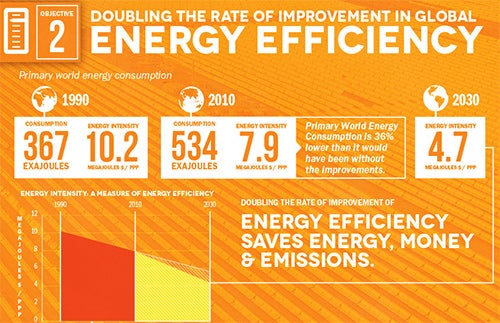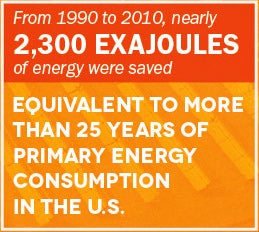
Energy is essential to heat homes and cook meals. It is needed to deliver proper health care in hospitals and to teach children. It is essential for economic growth and development and for powering industries, farms and businesses. It is at the heart of any effort to make a better life possible for people all over the world, in particular for the world’s poorest.
First, energy has to be produced, and it needs to increasingly be produced in sustainable ways as the world steps up to the challenges of climate change. At the same time, improvements in how efficiently our buildings, factories, vehicles and appliances use energy offer huge potential to get more benefit out of less energy. Energy efficiency can make energy more affordable for the poor, and it can reduce emissions.
This is why energy efficiency is an important element of the World Bank Group’s recent Energy Sector Directions Paper. It is reflected in the Bank Group’s growing energy efficiency portfolio. Lending for energy efficiency work has increased, totaling $7.5 billion for fiscal years 2008-2013, accounting for roughly 15.3% of all energy financing approved in that period.
This has included support for a national program in Mexico, in which the government set up 1,110 points of exchange at which millions of people turned in incandescent light bulbs in return for 22.9 million more efficient CFLs, achieving a total saving of about 1,400 gigawatt hours, as much energy as is consumed in the entire Mexican state of Nayarit or Colima. It earned Mexico an entry in the Guinness Book of World Records for the number of light bulbs distributed.
The Bank’s engagement in energy efficiency also includes more than $3 billion in financing in the past decade to Eastern Europe and Central Asia, helping countries like Belarus, which reduced its energy intensity by 60% over the past 15 years, and Uzbekistan, which saved 50,000 megawatt hours of energy that would otherwise have been lost to inefficiencies. Total savings to the region from energy efficiency projects, programs, and initiatives over the last 10 years are estimated at 42.5 TWh per year, equivalent to the total amount of power generated in New Zealand in 2010. Investments in the region are already saving an estimated 7.5 million tons of CO2 every year.
The Bank Group has also been working closely with China to support its energy efficiency efforts in major cities such as Shanghai, providing advice and financing to retrofit inefficient buildings. This project and others have contributed to China’s energy efficiency achievements, whose scale was revealed in the recent Sustainable Energy for All Global Tracking Framework Report. It found that China’s energy efficiency drive has resulted in the world's largest absolute energy savings for a single country.
Almost half of all energy generated across the world is used to cool, light, and ventilate buildings. Much of the Bank Group’s energy efficiency support has therefore provided financing and policy advice on public procurement of energy efficient services and products in cities and buildings. Improving planning in cities – particularly the fast-growing megacities of the developing world – is critical to the transition to a more sustainable energy future. The Bank’s Energy Sector Management Assistance Program (ESMAP) has developed the TRACE tool to help municipal governments identify and prioritize opportunities to reduce urban energy use. In Rio de Janeiro, TRACE is being used to help make next year’s FIFA World Cup and the 2016 Summer Olympics the most energy efficient ever.
The Bank Group’s International Finance Corporation is also working directly with investors and through financial intermediaries to provide financing in this area, including through the Excellence in Design for Greater Efficiencies (Edge) Green Buildings Certification System, which is helping owners design and retrofit buildings to be more sustainable.
 Energy efficiency improvements are a crucial part of any effort to reduce carbon emissions and keep global warming below the critical level of 2 degrees Celsius. Such improvements can also deliver huge savings in energy costs to households, as well as production, mining, manufacturing, and commercial operations in public and private sectors alike. Those are two reasons why doubling the rate of improvement in energy efficiency by 2030 is one of the three goals of the Sustainable Energy for All initiative, co-chaired by World Bank Group President Jim Yong Kim and UN Secretary General Ban Ki-moon. No doubt about it: energy efficiency is scaling up to cut costs and emissions. May the efforts multiply!
Energy efficiency improvements are a crucial part of any effort to reduce carbon emissions and keep global warming below the critical level of 2 degrees Celsius. Such improvements can also deliver huge savings in energy costs to households, as well as production, mining, manufacturing, and commercial operations in public and private sectors alike. Those are two reasons why doubling the rate of improvement in energy efficiency by 2030 is one of the three goals of the Sustainable Energy for All initiative, co-chaired by World Bank Group President Jim Yong Kim and UN Secretary General Ban Ki-moon. No doubt about it: energy efficiency is scaling up to cut costs and emissions. May the efforts multiply!
Related
Infographic: Sustainable Energy for All - What Will it Take?



Join the Conversation